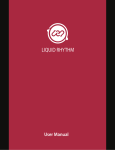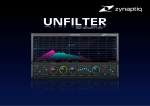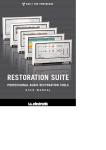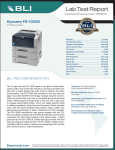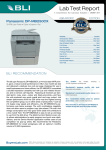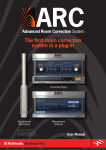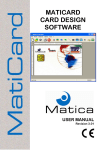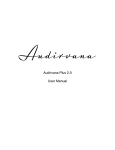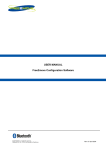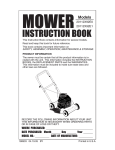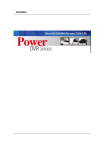Download Ricochet Manual
Transcript
Ricochet User’s Guide
Audio Damage, Inc.
Release 1.0
7 February 2008
The information in this document is subject to change without notice and does not represent a commitment on
the part of Audio Damage, Inc. The software described by this document is subject to a License Agreement
and may not be copied to other media except as specifically allowed in the License Agreement. No part of this
publication may be copied, reproduced or otherwise transmitted or recorded, for any purpose, without prior
written permission by Audio Damage, Inc.
© 2008 Audio Damage, Inc. All rights reserved.
Credits
Software Design and Construction, Documentation
Chris Randall
Adam Schabtach
Field Testing
Wade Alin
Dean Dunakin
Matt Giant
Steve Hamann
William Selman
Made Possible By
Tracie Bork
Lisa Randall
Fuzzy Logic
Alex
Chica
Pablo
Widget
In memory of Fatty
License Agreement
BY INSTALLING THE SOFTWARE, YOU ARE CONSENTING TO BE BOUND BY THIS AGREEMENT. IF YOU DO NOT
AGREE TO ALL OF THE TERMS OF THIS AGREEMENT, THEN RETURN THE PRODUCT TO THE PLACE OF
PURCHASE FOR A FULL REFUND.
Single User License Grant: Audio Damage, Inc. ("Audio Damage") and its suppliers grant to Customer
("Customer") a nonexclusive and nontransferable license to use the Audio Damage software ("Software") in
object code form solely on a single central processing unit owned or leased by Customer.
Customer may make one (1) archival copy of the Software provided Customer affixes to such copy all
copyright, confidentiality, and proprietary notices that appear on the original.
EXCEPT AS EXPRESSLY AUTHORIZED ABOVE, CUSTOMER SHALL NOT: COPY, IN WHOLE OR IN PART,
SOFTWARE OR DOCUMENTATION; MODIFY THE SOFTWARE; REVERSE COMPILE OR REVERSE ASSEMBLE ALL
OR ANY PORTION OF THE SOFTWARE; OR RENT, LEASE, DISTRIBUTE, SELL, OR CREATE DERIVATIVE WORKS
OF THE SOFTWARE.
Customer agrees that aspects of the licensed materials, including the specific design and structure of
individual programs, constitute trade secrets and/or copyrighted material of Audio Damage. Customer agrees
not to disclose, provide, or otherwise make available such trade secrets or copyrighted material in any form to
any third party without the prior written consent of Audio Damage. Customer agrees to implement reasonable
security measures to protect such trade secrets and copyrighted material. Title to Software and
documentation shall remain solely with Audio Damage.
LIMITED WARRANTY. Audio Damage warrants that for a period of ninety (90) days from the date of shipment
from Audio Damage: (i) the media on which the Software is furnished will be free of defects in materials and
workmanship under normal use; and (ii) the Software substantially conforms to its published specifications.
Except for the foregoing, the Software is provided AS IS. This limited warranty extends only to Customer as
the original licensee. Customer's exclusive remedy and the entire liability of Audio Damage and its suppliers
under this limited warranty will be, at Audio Damage or its service center's option, repair, replacement, or
refund of the Software if reported (or, upon request, returned) to the party supplying the Software to
Customer. In no event does Audio Damage warrant that the Software is error free or that Customer will be
able to operate the Software without problems or interruptions.
This warranty does not apply if the software (a) has been altered, except by Audio Damage, (b) has not been
installed, operated, repaired, or maintained in accordance with instructions supplied by Audio Damage, (c) has
been subjected to abnormal physical or electrical stress, misuse, negligence, or accident, or (d) is used in
ultrahazardous activities.
DISCLAIMER. EXCEPT AS SPECIFIED IN THIS WARRANTY, ALL EXPRESS OR IMPLIED CONDITIONS,
REPRESENTATIONS, AND WARRANTIES INCLUDING, WITHOUT LIMITATION, ANY IMPLIED WARRANTY OF
MERCHANTABILITY, FITNESS FOR A PARTICULAR PURPOSE, NONINFRINGEMENT OR ARISING FROM A
COURSE OF DEALING, USAGE, OR TRADE PRACTICE, ARE HEREBY EXCLUDED TO THE EXTENT ALLOWED BY
APPLICABLE LAW.
IN NO EVENT WILL AUDIO DAMAGE OR ITS SUPPLIERS BE LIABLE FOR ANY LOST REVENUE, PROFIT, OR
DATA, OR FOR SPECIAL, INDIRECT, CONSEQUENTIAL, INCIDENTAL, OR PUNITIVE DAMAGES HOWEVER
CAUSED AND REGARDLESS OF THE THEORY OF LIABILITY ARISING OUT OF THE USE OF OR INABILITY TO
USE THE SOFTWARE EVEN IF AUDIO DAMAGE OR ITS SUPPLIERS HAVE BEEN ADVISED OF THE POSSIBILITY
OF SUCH DAMAGES. In no event shall Audio Damage's or its suppliers' liability to Customer, whether in
contract, tort (including negligence), or otherwise, exceed the price paid by Customer. The foregoing
limitations shall apply even if the above-stated warranty fails of its essential purpose. SOME STATES DO NOT
ALLOW LIMITATION OR EXCLUSION OF LIABILITY FOR CONSEQUENTIAL OR INCIDENTAL DAMAGES.
The above warranty DOES NOT apply to any beta software, any software made available for testing or
demonstration purposes, any temporary software modules or any software for which Audio Damage does not
receive a license fee. All such software products are provided AS IS without any warranty whatsoever.
This License is effective until terminated. Customer may terminate this License at any time by destroying all
copies of Software including any documentation. This License will terminate immediately without notice from
Audio Damage if Customer fails to comply with any provision of this License. Upon termination, Customer
must destroy all copies of Software.
Software, including technical data, is subject to U.S. export control laws, including the U.S. Export
Administration Act and its associated regulations, and may be subject to export or import regulations in other
countries. Customer agrees to comply strictly with all such regulations and acknowledges that it has the
responsibility to obtain licenses to export, re-export, or import Software.
This License shall be governed by and construed in accordance with the laws of the State of Illinois, United
States of America, as if performed wholly within the state and without giving effect to the principles of conflict
of law. If any portion hereof is found to be void or unenforceable, the remaining provisions of this License
shall remain in full force and effect. This License constitutes the entire License between the parties with
respect to the use of the Software.
Introduction
Thank you for purchasing Ricochet, Audio Damage’s multi-tap delay plug-in. Ricochet combines a
sophisticated and novel multi-tap delay architecture with a simple user interface. Ricochet includes an EQ-like
input filter, separate resonant multi-mode filters on each of its five output taps, and a chorus processor.
Ricochet can create a wide variety of effects from simple delays and filters to stereo choruses and ping-pong
delays, complex rhythmic repeats, simple reverberation, and more. Ricochet syncs to the tempo of your host
digital audio workstation (DAW) software and fully supports parameter automation.
Ricochet is provided as both a VST and an AudioUnit plug-in for Windows and MacOS X. The MacOS X version
is a Universal Binary, compatible with both Intel- and Motorola-based Macs.
System Requirements
To use Ricochet, you'll need a Steinberg VST-compatible host application which conforms to the VST 2.0
specifications, and a computer capable of running it. For the AudioUnit version of Ricochet, you’ll need an
application capable of hosting AudioUnit plug-ins, and a computer capable of running it. The following
specifications represent minimum requirements.
For use with Microsoft Windows:
For use with Apple Macintosh:
Windows XP or Vista
Mac OS X version 10.4 or newer
512 MB RAM
512 MB RAM
Pentium III 600 MHz CPU
Motorola G4/G5 or Intel CPU
High Color S-VGA Display
Display capable of “thousands of colors”
Installation
Double-click the Ricochet Installer icon and follow the instructions. During the installation process the installer
will ask you to enter your registration code. Your registration code uniquely identifies your purchase, and you
will need it if you need to reinstall your plug-in (for example, after upgrading to a new computer). Keep a
copy of the code in a safe location and please don’t share it with your friends. We’re delighted if you like our
products so much that you want to share them, but please ask your friends to buy their own copy so that we
can keep making new products.
To un-install from OS X, simply delete the plug-in from your VST folder, which is usually located at
/Library/Audio/Plug-Ins/VST/, and your AudioUnits folder, which is located at /Library/Audio/PlugIns/Components/. To un-install from Windows, simply delete the plug-in from your VST folder, which is
usually located at C:\Program Files\Steinberg\VstPlugins.
Operation
Ricochet can be used in either a stereo or mono context in your host DAW software. If you use a stereo input,
the left and right channel separation of the input signal is preserved in the output signal (assuming that some
amount of the unprocessed signal is present in the output; see the description of the MIX knob below).
Ricochet can be used either as an insert effect or a send/return effect; in the latter case rotate the MIX knob
fully clockwise so that none of the dry signal is added in the return signal.
Ricochet’s knobs respond to vertical mouse-pointer movements; that is, click on a knob and drag upwards and
downwards to rotate the knob. If you’re using the VST version of Ricochet, your host software may override
this behavior. You will discover that the current value of the knob’s parameter is displayed in a pop-up
indicator when you click on a knob.
Here is a screenshot of Ricochet, followed by detailed descriptions of its controls.
1. Filter
The FILTER knob controls a filter that the input signal passes through before entering the pre-delay. The filter
is not a simple fixed-response tone control, but instead is an equalizer-like pair of shelving filters, one low-cut
filter and one high-cut filter. The FILTER knob is bidirectional. At its center “12 o’clock” position, the filters
have a flat response and do not affect the sound of the signal. As you rotate the knob anti-clockwise, the
high-cut filter removes an increasing amount of the signal’s higher frequencies. Conversely, as you rotate the
knob clockwise from the center position, the low-cut filter removes an increasing amount of the signal’s lower
frequencies. In simpler terms, the FILTER knob makes the sound darker or duller as you rotate it
counterclockwise, and brighter or thinner as you rotate it clockwise.
Note that the FILTER knob controls the amount that the low- or high-cut filter reduces the signal’s frequency
content. This differs from the behavior of most filter knobs, which usually control the range over which the
filter reduces the signal’s frequency by changing the corner frequency of the filter. You can change the corner
frequencies of Ricochet’s filters with the FILTER FREQUENCY sliders found on the modulation display, which
you invoke by clicking the MOD button in the lower-left corner of Ricochet’s window. You may find that you
need to adjust one of the FILTER FREQUENCY sliders at the same time you’re using the FILTER knob to dial in
the sonic character you’re seeking.
2. Pre-Delay Time
Ricochet contains two delays in series: a simple pre-delay followed by the main delay with its five output taps.
The PRE-DELAY TIME knob sets the length of the first delay. If the SYNC switch at the bottom of Ricochet’s
window is off, the pre-delay time is set in units of milliseconds. If the SYNC switch is on, the pre-delay time is
calculated from the current tempo of your host sequencer and the PRE-DELAY TIME knob operates in metrical
units. For example, setting the PRE-DELAY TIME knob to “1/8” will produce a delay time equal to an eighthnote’s duration, regardless of the current tempo of your song. In either case the delay time is displayed as
you move the knob. The pre-delay has a maximum length of 4 seconds.
Since the pre-delay comes before Ricochet’s main, multi-tapped delay line, the effective delay time of any of
Ricochet’s output taps depends upon the settings of the PRE-DELAY TIME knob, the GRID SIZE knob, and the
position of the tap’s control dot.
3. Feedback
The FEEDBACK knob controls how much of the delayed signal is fed back into Richochet’s input. With no
feedback, each of Ricochet’s five output taps will produce a single delayed copy of the input signal. Feedback
sends some amount of the delayed signal(s) back into Ricochet’s input, producing a decaying series of copies.
Like the FILTER knob, the FEEDBACK knob is bidirectional, and causes different things to happen depending
on the direction that you rotate it. At its center position, no feedback happens and the knob has no effect. If
you rotate the knob clockwise, an increasing amount of the pre-delay’s output is fed back into Ricochet’s
input. None of the signals from the output taps is fed back. If you rotate the knob anti-clockwise, the opposite
happens: an increasing amount of the signals from the output taps (all of them) is fed back into the plug-in’s
input, and none of the pre-delay’s output is fed back directly. As you’ll see when you move the FEEDBACK
knob, these modes of operations are referred to as “Echo” and “Reverb” respectively. Since the Echo mode
produces simple repetitions of the input signal before it passes through the multi-tap delay line, it is useful for
producing discrete echo effects. The Reverb mode recirculates all of the delayed signals that emerge from the
multi-tap delay and hence can produce reverberation-like accumulations of delayed sounds.
If you’ve been paying close attention, a question may now arise in your mind: what happens if the pre -delay
time is zero and the Echo mode is employed? Wouldn’t that create a feedback loop with zero delay time? Good
question and the answer is yes, it would. However, this isn’t terribly useful, so Ricochet has a special trick for
just this situation. If the pre-delay time is zero and you rotate the FEEDBACK knob clockwise to engage the
Echo mode, the pre-delay’s output is not used for the feedback signal. Instead, a hidden, extra tap on the
main delay line is used for the feedback signal. This tap’s delay time is permanently fixed at 1/4th of the time
set with the GRID SIZE knob. (Much more information about the Grid Size knob and the output taps lies
ahead, so keep reading.)
In both modes, the FEEDBACK knob has a maximum value of unity gain. This permits delayed signals to
repeat many times before fading out. However, if any of the tap output filters have high resonance settings,
the feedback signal can become louder and louder. As always, be careful of your ears when monitoring the
output of your DAW.
4. Tap Dots
The five circles on Ricochet’s grid display, called the tap dots, control the delay time and output level (or
volume) of the five taps on Ricochet’s main delay. In brief, moving the dot left and right changes the tap’s
delay time and moving it up and down changes its output level. Click on the dots and drag them with your
mouse to move them around.
The horizontal position of a tap dot expresses the tap’s delay time relative to its horizontal location on the
grid, and as a fraction of the time represented by the grid. This time is set by the GRID SIZE knob. If the tap
dot is at the far left side of the grid, its delay time is zero. If the tap dot is at the horizontal center of the
grid—that is, the position marked “08” at the bottom of the grid, or halfway across the grid—its delay time is
half of the time set by the Grid Size knob. If the tap dot is at the far right of the grid, at the position marked
“15”, the tap’s delay time is 15/16 of the time set by the Grid Size knob. Why 15/16? Because the Grid Size
knob sets the time represented by the grid to simple subdivisions of a measure (when the SYNC switch is
turned on). 15/16 is the last sixteenth of that unit of time; 16/16 is the same as the first position of the next
unit of that time, and hence a value that can be covered by other settings of the tap time and pre-delay time1.
The vertical position of a tap dot determines how much of that tap’s output signal is present in the plug-in’s
output—that is, it sets the volume of the tap. If the tap dot is at the bottom of the grid, the tap will be silent
(or nearly so). As you move the tap dot towards the top of the grid, the tap signal becomes louder. The
vertical position also determines how much of the tap’s output is sent back to the input of Ricochet if the
FEEDBACK knob is rotated anti-clockwise to engage the “reverb” feedback mode.
There are several other parameters associated with each tap. The controls for these parameters are tucked
away in a small panel which pops up when you right-click on a tap dot with the mouse. If you’re using a
mouse with only one button, hold down the CTRL key on your keyboard while clicking to bring up the panel.
The panel will stay open until you dismiss it by either right-clicking again on the tap, or right-clicking on a
different tap to invoke its panel. The panel looks like this (see next page):
1
If you find this confusing, it might help to think of it this way: a TR-style drum machine has 16 buttons representing 16
steps in a pattern. The first button is labeled “1” and it represents the step which starts at the beginning of the pattern. The
last button is labeled “16” and represents the step which starts 15/16ths of the way through the pattern, because there’s
still 1/16th of the pattern’s time left when that step begins. There is no 17 th button because it would have to represent the
first step of the next pattern. Since Ricochet is a delay and not a drum machine, its 16 “steps” are numbered 0-15 because
they represent delay times with a value of zero or greater.
On the left of the panel are three vertical sliders, labeled PAN, FRQ, and RES. Click and drag on them to move
them up and down.
The PAN slider moves the tap’s output between Ricochet’s left and right output channels. Move the slider
upwards (from its center position) to move the tap’s output towards the right, move it downwards to move
the tap’s output to the left. Obviously if you’re using Ricochet in a mono-output context, the PAN slider has no
effect.
Each of Ricochet’s output taps has a multi-mode, two-pole, resonant filter. These filters operate separately
(and independently of the filters controlled by the FILTER knob). The FRQ slider sets the operating frequency
of the filter. Moving the slider upwards increases the filter’s frequency. The audible effect of increasing the
filter’s cutoff frequency depends upon the current response mode of the filter, low-, band-, or high-pass.
The RES slider sets the amount of resonance of the tap’s filter. Moving the slider upwards increases the
resonance. A higher amount of resonance causes the filter to emphasize or amplify signals near its operating
frequency. High resonance values will produce a whistling or ringing sound when the filter’s low-pass or highpass modes are used. When the band-pass mode is active, the resonance control effectively sets the width of
the frequency band that the filter allows to pass; higher values make the band narrower.
The MODE switch to the right of the sliders chooses the response mode of the filter. The modes are:
LPF: low-pass filter. This mode causes the filter to attenuate or reduce signal frequencies higher than
its operating frequency (set by the FRQ slider) and pass unchanged signals lower than its operating
frequency. Low-pass filters are the most commonly used filters in synthesizers and effects processors.
HPF: high-pass filter. This mode causes the filter to attenuate signal frequencies lower than its
operating frequency and pass unchanged signals higher than its operating frequency.
BPF: band-pass filter. This mode causes the filter to attenuate signal frequencies higher and lower
than its operating frequency, and pass signals near its operating frequency.
Click on the abbreviated name to change the filter’s response mode.
The SNAP switch at the right of the panel determines how the tap dot moves horizontally when you drag it
with the mouse. If the SNAP switch is on, the tap dot will jump from one vertical grid line to the next as you
move it; that is, it will snap to the nearest line. This lets you easily set the tap times to rhythmically useful
values, since the grid lines divide the delay time into 16 units. If the SNAP switch is off, the tap dot can be
moved freely within the grid. The SNAP switch has no effect on the vertical movement of the tap dot.
The SOLO and MUTE buttons near the top right of the panel behave like the solo and mute controls on a
mixer. If you click on the SOLO button, you will hear only that tap’s signal in Ricochet’s output. Only one tap
can be soloed at a time. If one tap’s SOLO button is turned on and you click on a different tap’s SOLO button,
the first tap’s SOLO button will be turned off. The MUTE button silences a tap. More than one tap can be
muted. The SOLO button takes precedence over the MUTE button; you can solo a muted tap without first unmuting it. The solo and mute status of the taps is reflected by the color of the tap dots. A muted tap has a red
dot and a soloed tap has an olive dot.
Text indicating which tap, 1 through 5, appears at the upper right of the popup panel. This numbering does
not affect the order of the taps along the delay line; for example, there’s no reason that tap #3 has to have a
longer delay time than taps 1 and 2. The reference numbers for the taps are only useful if you’re examining
automation data for the plug-in.
5. Grid Size
The GRID SIZE knob sets the maximum time of Ricochet’s main, multi-tap delay. If the SYNC switch at the
bottom of Ricochet’s window is off, the grid size is set in units of milliseconds. If the SYNC switch is on, the
grid size is calculated from the current tempo of your host sequencer and the GRID SIZE knob operates in
simple fractions of the duration of one measure. In either case the delay time is displayed as you move the
knob. The values available when the SYNC switch is on are ¼, ½, 1, and 2. For example, setting the GRID
SIZE knob to “1/2” will set the grid size to half a measure. If you then move one of the tap control dots to the
position marked “04”, that tap will have a delay time equal to an eighth-note’s duration (assuming that the
pre-delay time is zero), regardless of the current tempo of your song, because 4/16 equals ¼, and ¼ times ½
equals an eighth2.
Now that we’ve examined all of the controls that determine the actual delay time for the output taps, let’s
reconsider how they all fit together. The Pre-delay Time knob controls sets the shortest time that the signal
will be delayed, since the pre-delay comes before the main multi-tap delay. Like the pre-delay parameter of a
reverb processor, the Pre-delay Time knob creates an offset between the original signal and the onset of the
processed signal. The Grid Size knob sets the length of the main multi-tap delay, and hence the range of delay
times available for the output taps. The positions of the tap dots determine the locations of the output taps
along the main delay, and hence the delay times of the outputs. These times are added to the pre-delay time.
This means that you can create changes in Ricochet’s overall effect simply by rotating the Pre-delay Time and
Grid Size knobs. Each of these knobs effectively changes the delay times of all of the output taps. Rotating the
Pre-Delay Time knob moves all of the taps while maintaining their delay times relative to each other, since the
pre-delay comes before the main delay and hence its time is added to the times of the taps. On the other
hand, rotating the Grid Size knob increases or decreases the delay times of the output taps relative to each
other, since the effective delay time of a tap is represented by the tap’s dot’s position on the grid and rotating
the knob changes the size of the grid.
2
Don’t panic if you do not consider math to be your strongest skill. You’ll find that you can turn on Ricochet’s SYNC switch
and forget about fractions altogether since the delay times are automatically calculated for you and Ricochet’s grid size is
deliberately restricted to simple divisions of a measure. You’ll also notice that the positions on the grid marked 00, 04, 08,
and 12 are highlighted as a gentle reminder that these positions will tend to produce the most rhythmically pleasing delay
times.
The maximum delay length for any of the tap outputs is four seconds. This means that the 2-measure setting
of the GRID SIZE knob is mostly useful at tempos above 120bpm, since two measures equals four seconds at
this tempo.
6. Mix
The MIX knob controls the relative amounts of the original, unprocessed (dry) signal and the processed (wet)
signal in Ricochet's output. Use this knob to control the overall amount of the effect. When the knob is rotated
fully anti-clockwise, you'll hear only the original signal. As you rotate the knob clockwise, the amount of wet
signal increases and the amount of dry signal decreases. At the center "12 o'clock" position, there is an equal
amount of wet and dry signal in the output. If you rotate the knob fully clockwise, you'll hear only the
processed signal.
7. Output Level
The OUTPUT LEVEL knob adjusts the overall loudness of Ricochet’s output. It affects the unprocessed and
processed signals equally. As you rotate the knob clockwise, Ricochet’s output becomes louder. Use this knob
to either tame excessively loud signals (which can be produced with high settings of the feedback knob) or to
boost quiet signals (which can be produced with filter settings that remove most of the input signal). The
control has a range of -40dB, which will silence all but the loudest signals, to +6dB, which will apply a gentle
amount of amplification.
8. Chorus, Saturation, and Filter Controls
Ricochet has a chorus processor in addition to its delays. The chorus processor can be used to thicken the
delayed sound and make it more spacious. The controls for the chorus processor are found on the Effects
Control panel which appears when you click the MOD button near the lower-left corner of Ricochet’s window.
The RATE slider sets the speed with which the chorus effect is modulated (changed) by a low-frequency
oscillator (LFO). As you move this slider upwards the modulation rate increases. The RATE control has a range
of 0.05 to 1Hz. Note that if the DEPTH slider (described next) is set to zero, you won’t hear any change in the
output when you move the RATE slider.
The DEPTH slider determines how much the chorus effect is modulated by the LFO. At its lowest setting, the
LFO has no effect and the chorus process acts like a short delay. As you move the DEPTH slider upwards the
modulation amount increases and chorus process has a more noticeable effect. You may find that you have to
adjust the RATE and DEPTH sliders together, e.g. a lower DEPTH setting might work better with a high RATE
setting and vice-versa.
The TIME slider sets the length of the delay used to create the chorus effect. Moving the TIME slider upwards
increases the delay time. The slider has a range of 5 to 25msec. The lowest settings can create flanging or
comb-filtering effects; higher settings create chorus and doubling effects.
The MIX slider controls the amount of the chorus effect that is added to Ricochet’s output. If the MIX slider is
at its lowest position the chorus effect is silenced. As you move the slider upwards the chorus effect becomes
louder. Note that the MIX slider does not reduce the level of the signal not processed by the chorus. At the
highest setting of the MIX slider, the chorused and non-chorused signals are combined in equal amounts.
The SOFT SAT slider controls the amount of soft-saturation distortion created within Ricochet’s feedback path.
The distortion section has two purposes: first, it prevents feedback signals from growing without limit; second,
it imparts a variable amount of analog-like distortion. This distortion can help repeated signals seem to break
up or decay and become less distinct. Moving the slider upwards increases the amount of distortion.
The Filter Frequency sliders at the bottom of the panel, labeled HI-CUT FREQ and LO-CUT FREQ, control the
corner frequencies of the two shelving filters present in Ricochet’s input section. The gains of these shelving
filters are controlled by the FILTER knob, described above. Moving the frequency sliders towards the right
increases the corner frequency of the associated filter. The low-cut filter frequency slider has a range of 20 to
10kHz and the high-cut filter slider has a range of 50 to 2kHz. Note that you won’t hear anything when you
move these sliders if the FILTER knob isn’t in the appropriate position. The FILTER knob must be rotated anticlockwise from its center position for the high-cut filter to have any effect, and rotated clockwise from center
for the low-cut filter to have any effect. Note that the locations of the sliders reflect their correspondence to
directions of rotation of the Filter knob: the HI-CUT FREQ slider is on the left, and the high-cut filter is active
when the Filter knob is rotated towards the left, whereas the low-cut filter is active when the knob is rotated
towards the right.
Click the GRID button at the lower-left corner of Ricochet’s window to switch back to the main delay display.
MIDI Controllers
The VST version of Ricochet responds to MIDI continuous controller messages. You can use hardware MIDI
controllers, such as MIDI slider boxes or the knobs found on some MIDI keyboards, to adjust Ricochet’s
parameters.
Ricochet has a simple “MIDI Learn” mode for assigning its controls to MIDI controllers. To assign a control to a
MIDI controller:
First, hold down the SHIFT and CTRL keys on your PC’s keyboard, or SHIFT and CMD keys if you’re
using a Mac, and click once on the control. A white box will be drawn around the control to indicate
that it is ready to learn which MIDI controller it will be assigned to.
Next, move the MIDI controller to send a continuous controller message—turn the knob, press the
button, move the slider, whatever is appropriate.
The white square will disappear. Now the control will move when you manipulate the MIDI controller.
Ricochet waits until it has received two consecutive continuous controller messages with the same controller
number before it makes an assignment. This filters out extraneous data sent by some MIDI controllers. If you
are assigning a button or switch on a MIDI controller, you may have to press or move the switch twice before
Ricochet recognizes the controller and assigns it to the desired control.
To assign a different MIDI controller to a control, repeat the same procedure using a different controller.
To cancel MIDI Learn mode without assigning a controller, hold down the SHIFT and CTRL keys (SHIFT and
CMD keys on a Mac) and click in any empty area in Ricochet’s window (i.e., don’t click on another control).
The white box will disappear.
To remove a MIDI controller assignment from a control, SHIFT and CTRL keys, (SHIFT and CMD keys on a
Mac) click on the control once so that the white box appears, then click again on the same control.
If you assign a MIDI controller to a tap dot, the MIDI controller will move the dot vertically but not
horizontally. In other words, you can use a MIDI controller to change a tap’s output level but not its delay
time.
Ricochet’s MIDI controller assignments apply to all presets and instances of Ricochet, in all host applications
that you use. The MIDI assignments are stored in a special file on your hard drive. The contents of this file are
read when Ricochet is loaded by your host. If you have two or more instances of Ricochet in use at once, any
MIDI assignments you make will not be propagated to the other instances until the next time that your host
loads the plug-ins.
The AudioUnit version does not provide the same MIDI assignment features as the VST version. Almost all
AudioUnit hosts provide their own mechanism for assigning MIDI controllers to parameters, so it would be
redundant for us to implement MIDI controller assignments in the plug-in itself. Consult the documentation for
your AudioUnit host to learn how to use its MIDI features.
Automation
All of Ricochet's parameters can be automated using your host's automation features. Consult your host's
documentation for information on how to use these features.
And Finally…
Thanks again for purchasing Ricochet. We make every effort to ensure your satisfaction with our products,
and want you to be happy with your purchase. Please write [email protected] if you have any
questions or comments.



















